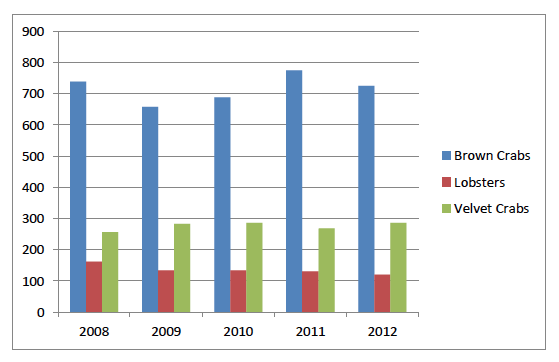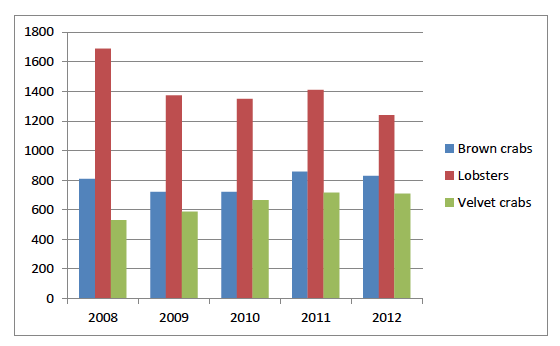Outer Hebrides Inshore Fisheries Group - Consultation on new Management Measures on Crabs and Lobster Landings into the Outer Hebrides
A consultation on management proposals for lobster, velvet crab and brown crabs landed into the Outer Hebrides. The management measures were developed by the Outer Hebrides Inshore Fisheries Group.
Consultation Document
Background on the Outer Hebrides IFG
The management proposals contained in this document were developed by the Outer Hebrides Inshore Fisheries Group.
Inshore Fisheries Groups ( IFGs) are non-statutory bodies whose purpose is to help improve the management of Scotland's inshore fisheries out to 6 nautical miles. A key aim of IFGs is to put commercial fishermen, assisted by government agencies and others with an interest in the marine environment, at the heart of developing initiatives for sustainable and profitable fisheries.
The membership of the Outer Hebrides IFG includes:
- Clyde Fishermen's Association
- Orkney Fisheries Association
- Mallaig & North West Fishermen's Association
- Scallop Association
- Scottish Pelagic Fishermen's Association Ltd
- Scottish White Fish Producer's Association Ltd
- Western Isles Fishermen's Association
With advice from:
- Scottish Natural Heritage ( SNH)
- Marine Scotland Science
- Marine Scotland Compliance
- Comhairle Nan Eilean Siar ( CNES)
- Scottish Environment Protection Agency
- Scottish Environmental LINK
After reaching consensus within its membership, the Outer Hebrides IFG has asked Marine Scotland to legislate to help secure the long-term sustainability of the brown crab, lobster and velvet crab fisheries in the area by increasing the minimum landing size of all three species and prohibiting the landing of 'crippled' female lobsters and larger female lobsters.
Background on Fisheries in the Area
Commercial fishing in the Outer Hebrides has changed significantly over the past 30 years. Previously, the industry had been built around larger vessels targeting white fish and pelagic species. However, changes in catching opportunities and decommissioning schemes have seen the structure of the industry change significantly to one which, on the whole, sees a smaller class of vessel targeting shellfish.
Shellfish now account for virtually all landings by value into ports in the Outer Hebrides and the majority are landed by boats that are owned and crewed by local residents. In places such as Barra and Grimsay, over 10% [1] of the population is involved in fish-catching activities. In addition to supporting the catching sector, the shellfish fisheries around the Outer Hebrides also sustain processors and export businesses throughout the island chain. It is therefore vital that the shellfish populations around the Outer Hebrides are harvested sustainably and at a level consistent with high long term yield.
The species involved in this consultation account for three of the five most profitable species landed into the region:
- Lobster (landings worth £1.2 million in 2012);
- Brown crab (landings worth £827,000 in 2012); and
- Velvet crab (landings worth £700,000 in 2012).
The figures below show the tonnage and value of crab and lobster landed into the Outer Hebrides from 2008 to 2012.

Table 1: Tonnage of brown crab, lobsters and velvet crab landed into the Outer Hebrides 2008-2012

Table 2: Value (£000) of brown crab, lobsters and velvet crab landed into the Outer Hebrides 2008-2012
The three species involved in this consultation are all taken in creel fisheries and are managed under a broadly similar framework:
- They are not subject to quota control under the EU Total Allowable Catch system
- Vessels fishing commercially for these species must have a shellfish entitlement associated with their licence
- Landings must comply with an EU set minimum landing size for the species
In addition, there are a number of species specific measures. Such as: an effort cap at a UK level for vessels over 15 metres in length targeting brown crab on the west coast of Scotland and a maximum landing size for female lobsters in Scotland.
State of the Stocks in Hebrides Region
Lobster
The latest stock assessments from Marine Scotland Science show that female lobsters are currently fished below the F MSY proxy (F MSY is the fishing mortality consistent with the largest average yield that can continuously be taken from a stock under existing environmental conditions). However, male lobsters are currently fished above F MSY (above the rate that maximizes long term average yield). The scientific advice is that increased long term average yield and biomass could be achieved if appropriate management measures were to be introduced.
Brown Crab
The latest stock assessments from Marine Scotland Science show that male brown crabs are currently fished below F MSY proxy (F MSY is the fishing mortality consistent with the largest average yield that can continuously be taken from a stock under existing environmental conditions). However, female brown crabs are fished above F MSY (above the rate that maximizes long term average yield). The scientific advice is that increased long term average yield and biomass could be achieved if appropriate management measures were to be introduced.
Velvet Crab
The latest stock assessments from Marine Scotland Science show that male crabs are currently fished below F MSY proxy (F MSY is the fishing mortality consistent with the largest average yield that can continuously be taken from a stock under existing environmental conditions). However, female velvet crabs are fished above F MSY (above the rate that maximizes long term average yield). The scientific advice is that increased long term average yield and biomass could be achieved if appropriate management measures were to be introduced.
Benefits of MLS
The aim of an MLS (which varies from species to species) --is to help prevent the landing of juvenile individuals. This allows them the opportunity to grow and reproduce before being harvested. An increase in MLS would allow more individuals the opportunity to reproduce before capture, potentially increasing long term yield and biomass.
A 2009 study on the effectiveness of management measures adopted by English Sea Fisheries Committees (the bodies responsible for regional inshore management in England prior to the Inshore Fisheries and Conservation Authorities) supported the adoption of regionally specific MLS provisions for shellfish. It stated that:
"In all cases regionally specific MLS byelaws have served the purpose for which they were designed and can be considered best practice for shellfisheries management" [2]
Staggering the Increase in MLS for Lobster
The Outer Hebrides IFG has proposed that the increase in MLS for lobster be staggered over two years. This would see an immediate increase from 87 mm to 88 mm and then, a year later, a further increase in MLS to 90 mm. This would allow fishermen the opportunity to adjust over the course of two years to the 90 mm limit.
A study on the benefits of various management measures in the English lobster fishery found that within two years of an increase in MLS to 90 mm those newly undersized lobsters could be harvested. [3]
A Maximum Landing Size for Lobsters
There is evidence that as female crustaceans grow larger they produce a greater number of eggs which are of a larger size and better quality. This may result in greater recruitment to these fisheries. The maximum landing size provision for female lobsters affords protection for these larger animals which have a greater spawning potential.
This, plus a market preference against larger lobsters, was the rationale behind the introduction of a maximum landing size for female lobsters in 2004.
The current maximum landing size for lobsters into Scotland is 155 mm. The IFG wishes this restriction to be reduced to 145 mm for female lobsters being landed into the Outer Hebrides.
Prohibiting the Landing of 'Crippled' Female Lobsters
A 'crippled' lobster refers to one which has lost one or both claws. These animals do not achieve the same as lobsters with both claws and if returned to the sea have the ability to re-grow these missing limbs. There is anecdotal evidence that many 'crippled' lobsters are already returned to the sea but in order to help protect stock numbers and increase spawning stock biomass, the IFG wishes to prohibit the landing of 'crippled' female lobsters.
Carriage Restriction
The new restrictions outlined would apply only to those vessels landing into the Outer Hebrides IFG area. Unless these new controls are accompanied by restrictions on the carriage (or retention on-board) of animals which mirror these landing restrictions then this will present compliance issues.
We therefore propose that, in addition to the new landing provisions outlined above, they are accompanied by carriage provisions which make it illegal to retain on-board animals that are not compliant with these new restrictions in the waters around the Outer Hebrides.
It is proposed that the new carriage restrictions apply to the six nautical miles around the Outer Hebrides.
Contact
There is a problem
Thanks for your feedback